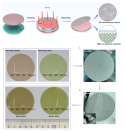Shangyang Software, in collaboration with Xinshun Microelectronics, has completed a comprehensive system upgrade, creating the "most powerful brain" for automotive-grade wafer manufacturing.
Shangyang Software and Jiangsu Xinshun Microelectronics announced the successful completion of a major manufacturing system upgrade described as creating the “most powerful brain” for automotive-grade semiconductor wafers.
Building on over 20 years of collaboration, Shangyang Software delivered a comprehensive overhaul of Xinshun Micro’s Manufacturing Execution System (MES) and pioneered the deployment of an advanced Equipment Execution System (EES), forming an integrated CIM (Computer-Integrated Manufacturing) solution tailored for high-reliability automotive production.
- Equipment Automation Platform (EAP): Enabled end-to-end digital control of wafer equipment from real-time monitoring and predictive anomaly alerts to closed-loop process parameter adjustment eliminating manual inspections and reducing human error.
- 100% Automotive-Grade Compliance: Fully integrated all automotive production equipment to ensure end-to-end traceability, capturing every process parameter and equipment log from raw material to finished wafer meeting the stringent stability and consistency demands of automotive semiconductors.
- Performance Gains:
- Increase product yield and qualification rates
- Reduced scrap and rework rates
- Decreased production cycle times
- Increase overall Factory Effectiveness (OFE) and equipment utilization
The upgrade transforms Xinshun Micro’s manufacturing into a data-driven, transparent, and standardized operation — shifting from reactive to predictive and precise control.
Shangyang Software emphasized its “technology adapted to needs” philosophy, aligning every system enhancement with Xinshun Micro’s operational realities and strategic goals. This project underscores a broader mission: empowering Chinese semiconductor firms to lead in high-end markets like automotive and industrial-grade chips.
Looking ahead, Shangyang Software will continue advancing CIM solutions to help domestic manufacturers strengthen global competitiveness and elevate “Made in China” in the critical semiconductor supply chain.
iangsu Xinshun Microelectronics Co., Ltd. specializes in the research, development, production, sales, and service of semiconductor chips. Currently, it operates one 5-inch and one 6-inch chip production line, providing customers with over 2,000 different specifications and models across six major series. Its products are widely used in energy conversion, green lighting, rail transportation, smart grids, smart homes, computer equipment, mobile devices, communications, and home appliances, covering numerous fields within the electronics and information industry.
Shangyang Software emphasized its “technology adapted to needs” philosophy, aligning every system enhancement with Xinshun Micro’s operational realities and strategic goals. This project underscores a broader mission: empowering Chinese semiconductor firms to lead in high-end markets like automotive and industrial-grade chips.
Looking ahead, Shangyang Software will continue advancing CIM solutions to help domestic manufacturers strengthen global competitiveness and elevate “Made in China” in the critical semiconductor supply chain.
iangsu Xinshun Microelectronics Co., Ltd. specializes in the research, development, production, sales, and service of semiconductor chips. Currently, it operates one 5-inch and one 6-inch chip production line, providing customers with over 2,000 different specifications and models across six major series. Its products are widely used in energy conversion, green lighting, rail transportation, smart grids, smart homes, computer equipment, mobile devices, communications, and home appliances, covering numerous fields within the electronics and information industry.



